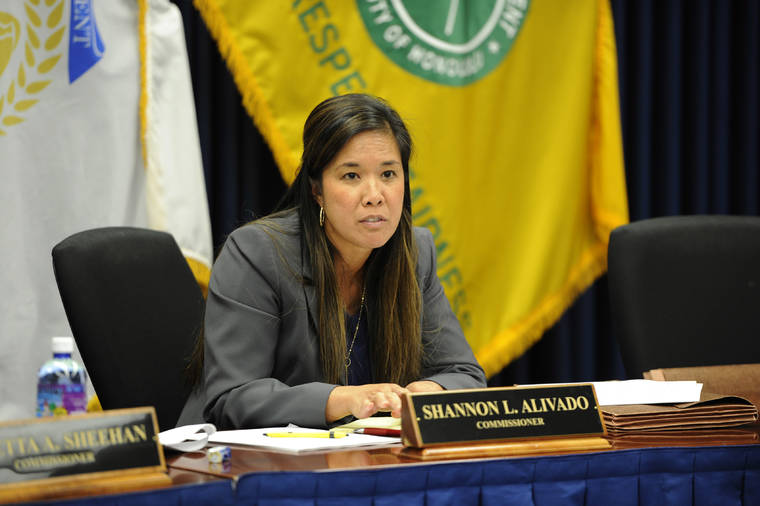Police panel leader says meeting to have video feed

BRUCE ASATO / MARCH 2019
Honolulu Police Commissioner Chairwoman Shannon Alivado and the staff are working to livestream meetings for the public.
The Honolulu Police Commission’s chairwoman said she and the commission staff have worked out a solution to include the public in the panel’s next regular meeting on May 6, which will allow for social distancing during the COVID-19 pandemic.
Despite concerns from members of the commission and the public, the commission proceeded Wednesday afternoon by teleconference with its second meeting in April that left individuals unable to testify in person or to hear the meeting, even failing to allow the media to cover it.
This was legal because the governor’s emergency proclamation with respect to COVID-19 suspended the Sunshine Law, a state requirement to open to the public any government meetings. However, the order says boards shall reasonably allow for public participation, allow submission of written testimony and livestreaming of meetings.
Commission Chairwoman Shannon Alivado said she and the staff have been working hard to livestream meetings. They considered Zoom, a video conferencing application, or FaceBook Live, but both raised security concerns, and cost was a factor with broadcasting by Olelo Community Media.
They opted for a closed-circuit television to show the meeting in an area with seating outside the main station’s front entrance and allow the public to view it while practicing social distancing, but that option may be replaced by some other platform, she said.
Alivado called the special meeting Wednesday to discuss an April 17 letter sent by Honolulu Police Chief Susan Ballard to Supreme Court Chief Justice Mark Recktenwald, which the chairwoman said she did due to the timeliness of the issues.
Don't miss out on what's happening!
Stay in touch with breaking news, as it happens, conveniently in your email inbox. It's FREE!
The chairwoman said they discussed potential support of the letter and a procedural matter.
While there was general support of the chief and what her duties call for her to do, “we didn’t feel like we had enough information and took no action with respect to the letter,” Alivado said.
Ballard wrote she objects to early release of inmates based on the possibility of a COVID-19 outbreak within correctional facilities and that if the Department of Public Safety is taking proper precautions and following federal guidelines, the risk to the prison population should be minimized.
Kat Brady, coordinator of the Community Alliance on Prisons, testified that the chief’s comments have been widely repeated and disproven by the evidence.
“Health experts say not testing staff could be a blind spot,” she wrote, citing an April 24 article titled, “These Prisons are Doing Mass Testing for COVID-19 and Finding Mass Infections.”
The article says in Arkansas, at the Cummins Unit, a farm employee tested positive in early April. Now 14 staffers and more than 680 of the prison’s nearly 1,700 prisoners have the virus.
In Ohio, the Marion Correctional Institution reported four deaths and more than 2,000 prisoners and 160 staffers have tested positive for the virus.
In Pickaway Correctional Institution, also in Ohio, at least nine prisoners have died, and more than 1,500 prisoners and 79 staffers have tested positive.
Commissioner Steven Levinson, a former Hawaii Supreme Court justice, said he raised the matter because it was the second time Ballard wrote directly to Recktenwald, despite an April 2 order that directed all communication concerning the issue of early release of inmates due to the coronavirus go to Special Master Dan Foley.
The Code of Judicial Conduct, Rule 2.9, prohibits judges from accepting ex parte communication — direct communication without notice to other parties to a court case, except under certain circumstances, Levinson said.
“The Supreme Court notified the parties of letters from Chief Ballard dated March 31 and April 17, as well as of other letters or communications sent to the court, but not provided to all parties in the case”, the Judiciary said in an email. “The parties were notified through notices filed in the record.”
“I thought it was something we should talk about, so that hopefully she wouldn’t do it again, that she would do it the right way,” Levinson said.
He said commissioners generally acknowledged it was worth calling the issue to the chief’s attention, but Ballard did not attend the meeting.
An HPD spokeswoman said Ballard was not notified by the court to do otherwise and wrote the letter out of concern for the community’s safety.
House Speaker Scott Saiki submitted testimony supporting the substance of the chief’s letter and its submission as a matter of procedure.
He wrote in his testimony: “The Supreme Court’s handling of this matter has been somewhat lax and informal. In fact, the proceeding was initiated by a letter that the State Public Defender sent to the Supreme Court on March 23, 2020.”
Saiki said his two letters in the case reflect the same public health and safety concerns that Ballard has, as well as those of the House of Representatives.
Levinson noted Saiki followed the court order and sent his letters to Foley, not the chief justice.




